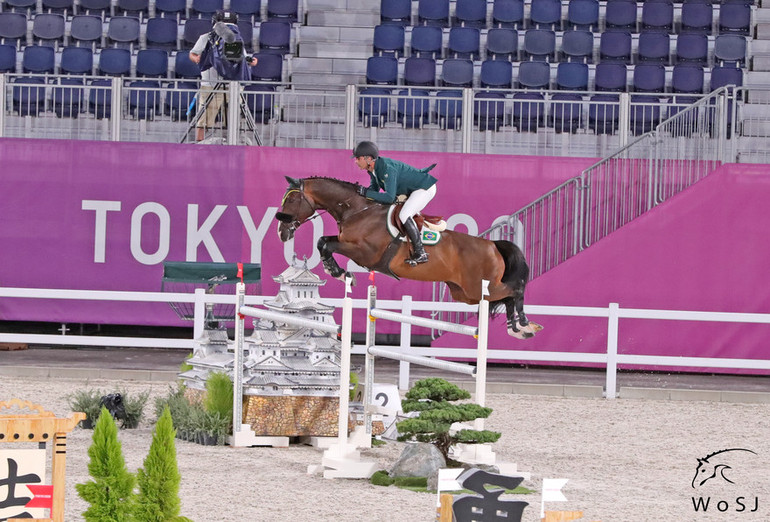Text © World of Showjumping
In the aftermath of the Olympic Games in Tokyo, the reactions to the new jumping format have been many. There are few that seem to appreciate the changes that were made by the FEI; with more flags – 34 compared to 27 in Rio and London, teams of three rather than four, no drop-score and the individual competitions before the teams. Who better to speak with than a living legend that himself became Olympic Champion in 2004, has two Olympic team bronze medals, and has competed a total of seven times at the Games? Rodrigo Pessoa shares his opinions.
A disaster waiting to happen
“I was actually Athlete Representative in the FEI Jumping Committee at the time when this was decided, and I must say that myself and Rob Ehrens (Editor’s note: Dutch Chef d’Equipe and member of the FEI Jumping Committee from 2015-2019) felt a little bit isolated there. We fought this decision very, very hard, with everything we could, but the FEI and the IOC wanted to go in a different direction, and we could not do anything about it.
The Olympic format was discussed over a span of four years in the Jumping Committee. On the riders’ behalf, Steve Guerdat fought it at the FEI Sports Forum and gave the explanations of everything that was going to happen. We had huge discussions at the International Jumping Riders Club’s general assemblies – both in 2016 and in 2019 – with the FEI present. In 2019, both Ingmar De Vos and Stephan Ellenbruch were there themselves. Steve, Eric Lamaze, Cian O’Connor, Kevin Staut, Max Kühner, Ludger Beerbaum, and myself, were all among the riders that warned the FEI about the potential disastrous consequences of this format. Still, the FEI pursued it. We riders knew that what happened in Tokyo was going to happen, because we have lived this sport from morning to night for almost our entire lives. No one needed a crystal ball to see that this was going to be a disaster. Anyone that has any knowledge, any clue about the sport, would have been able to see that this was not going to work out.
No one needed a crystal ball to see that this was going to be a disaster
Despite all the disasters in Tokyo, we were still very lucky and that comes down to two factors: 1) Course designer Santiago Varela – who did an unbelievable job – and 2) The horses and the riders. They did their job: They made the show. Despite the bad format, the sport was unbelievable, but only because of the course builder, as well as the horses, riders and their staff – and not because of the format.
For the riders it is comforting to know that we were right; we proved the FEI wrong. Now we have to put our sleeves up and change the format to what we want it to be. And the FEI better listen this time!
The number one priority is of course the welfare of the horse
In this day and age, there are three important parameters to take into account for all jumping championships: The number one priority is of course the welfare of the horse; secondly, we want to jump less in order to – number three; get a great winner through top sport. This will be the basis of the formula we now need to figure out. We need to find a way to reduce the amount of jumping, just like with the World Equestrian Games where the final four was cut – it was just too much for the horses and not in their best interest. Still, after these changes were made, if you look back at the horses that finished in the Top 10 at the World Equestrian Games in Tryon, only two or three are still competing at top level. The others have been struggling with injuries or are no longer in the sport. So, we have to ask ourselves: How do we jump the horses less but still have good sport? This is where we are going to put our heads together and come up with a system that is fair, is inclusive in the spirit of the Olympics, but still hard enough so that deserved winners can come out. I am sure though that we will manage to find the right formula, because as riders we know what we are talking about.”
The Swedes beat a broken system
“We had great winners in Tokyo too, but the system was unfair. To have the individual competitions first makes no sense. If you compare the American and Swedish horses that competed for the gold and the silver medals in the team final, the Swedish horses jumped one round and one jump-off more than the American horses. This was a huge disadvantage for the Swedish horses, and totally wrong. In the end, the Swedes beat a broken system – luckily! What we saw last week from the Swedes, we will never in our lifetime see again: In less than one week, the three Swedish horses jumped 86 efforts each, 258 efforts in total, and made only two mistakes. What we witnessed was a display of great horsemanship, perfect technicality and a 99.9% execution.
We had great winners in Tokyo too, but the system was unfair
We can also not have horse-and-rider combinations travelling to the other side of the world to compete, but who end up having to go home after doing one round just because they had an unlucky mistake and are out.
We have to go back to start with the teams, where the individuals jump as well, and then we make cuts from the beginning, moving the best forward phase by phase.”
There is no question about it: The drop-score has to come back
“Under the old format, the teams carried forward faults into the final. Such a system rewards consistency. That being said, I could live with starting over on a zero-penalty score for the final – but on the condition that we get going with the teams first and bring the drop-score back.
Look at France. They jumped two rounds with a time fault per rider in the final and were in the lead before their last pair got eliminated – because there was no drop-score. They were defending champions, worked four years towards Tokyo, invested millions of Euros, then a horse has a mishap – which can happen to anybody – and the team is out.
There is no question about it: The drop-score has to come back. We are doing this sport with an animal. You cannot compare it to the 400m relay in athletics, where you are out if you drop the baton – those are people, we are dealing with horses. You can say: “Hi, if you drop the baton, we are out – so be careful.” The horse does not know it’s the Olympic Games, that it cannot make a mistake. You cannot hang one nation’s hopes, efforts and investments on a balance like in Tokyo – what happened to Daniel Deusser and Penelope Leprevost could happen to anyone, these are two of the best riders in the world.
The FEI has argued that the drop-score is confusing and difficult to understand for a non-equestrian audience. If it’s explained properly, is that really so?
What I liked about the format in Tokyo though, was the opportunity to bring a new rider in on the team. I think we need to look at the possibilities to keep this as an option. Just to illustrate: What Harrie Smolders did on the Dutch team, going in like that on the last day of the team competition after being on the side-line the whole week to jump clear – that was incredible. It takes a very brave rider to do that, and also a brave Chef d’Equipe to make that decision. That’s a drama, but good drama!
The FEI has argued that the drop-score is confusing and difficult to understand for a non-equestrian audience. If it’s explained properly, is that really so? ‘Look: There are four team members, you take the worst score out’ – how complicated is that to understand? When they do diving, or gymnastics, they get eight scores, drop two and end at six that count – that’s drop scores, so it’s the same and people understand. Saying that the drop-score is confusing was a lame excuse from the FEI to get to the result they wanted.”
There are fundamentals in our sport that we can’t move away from
“The FEI’s mantra in this process has been that the IOC put pressure on. Equestrian sports had to either change or be changed. We were in danger as an Olympic sport if we did not adjust. But what we saw in Tokyo is what causes real danger to the sport. A rider should never be put in the position that he or she has to finish the round, otherwise the country gets eliminated. That’s where the drop score is crucial.
I am open to having more flags at the Olympic Games, but the horse-and-rider combinations competing must have earned their place. There are fundamentals in our sport that we can’t move away from. These are the Olympic Games; you should not be able to go there because you come from an equestrian under-developed country and it’s easy to qualify – that is not how it is supposed to be.
We do have to worry to be inclusive, but we should not design the system around the goal of having as many flags as possible
The Certificate of Capability have been discussed on numerous occasions. The FEI have themselves said this would become a much stricter affair and that it would be an “honest and fair test”. Yet again, this year, we had a special competition in Hagen where horses and riders could earn their Certificate of Capability. Riders from China, Denmark, Great Britain, Japan, Jordan, Latvia, Morocco and Sri Lanka were among those who sent potential Olympic horse-and-rider combinations there to obtain their Certificate of Capability. Two of the riders that obtained their Certificate of Capability at this event did not make it through day one of the Olympic Games; one was eliminated and one retired.
These competitions are wrong: The Certificate of Capability should only be rewarded to horse-and-rider combinations that can produce a relevant result in a real international CSI or CSIO competition, with the atmosphere and stress that comes with. To once have twelve faults in a five-star Grand Prix, or to go jump at a special Certificate of Capability competition – anyone can do that. It needs to be much harder and that will solve the problem of the flags. For the Certificate of Capability, you have to be able to go in a five-star Grand Prix or a Nations Cup and jump at least one clear round, probably even two.
The Certificate of Capability should only be rewarded to horse-and-rider combinations that can produce a relevant result in a real international CSI or CSIO competition
Talking about flags and universality. In London, Saudi Arabia moved on to the final, in Rio, it was Qatar – this time it was Argentina. Otherwise, the players are the players – because they are the best in the world. For the other nations outside this group of countries, it is unlikely to move on to the final – for this they need more experience and practice in high-level Nations Cups first. If you can’t win a Nations Cup in Geesteren, La Baule or Rome, you are not going to win the Olympic team competition.
We do have to worry to be inclusive, but we should not design the system around the goal of having as many flags as possible. If we keep on pushing to include more and more riders from nations that are not ready to compete at this level, it will end with someone getting badly hurt. Then we are also back to the importance of having an extremely good course designer – like in this case Santiago Varela – because he or she is going to dictate the outcome. It’s a huge responsibility, and you can only take the best course designer there is for occasions like these.
A good cook will prepare an excellent meal even with bad ingredients
I can only compare the jumping competitions in Tokyo to giving a really good cook bad ingredients, but still, he or she manages to serve an excellent meal.
Santiago Varela did a brilliant job in Tokyo – he deserves a double gold medal around his neck. The horses, the riders and their staff also did their job – simply because they are great at what they are doing.
The IJRC Board is already uniting, and we are all in agreement to come up with a proposal that will be sent to the FEI very shortly. Because if we continue playing this game, then we will very soon be out of the Olympics!”
- As told to World of Showjumping by Rodrigo Pessoa -
No reproduction without written permission, copyright © World of Showjumping









